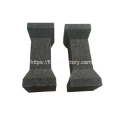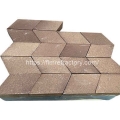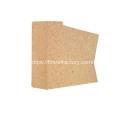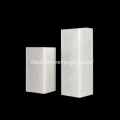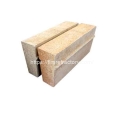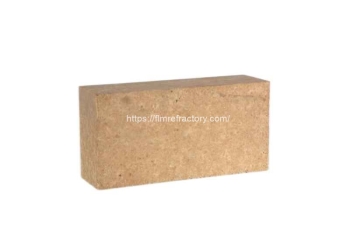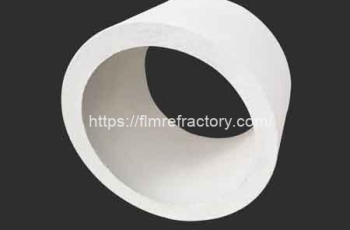- Performance. Innovation. Worldwide. Your trustworthy Refractories Manufacturing Partner--Fireramo
- +86 175 3769 7777
Anchor brick
- Category: Alumina Brick
- |
- Author: Fireramo
Anchor bricks are specially shaped bricks used in refractory masonry that have a structural design that allows the anchors to nest into each other. The use of anchor bricks contributes to the stability and overall strength of the masonry structure, especially in harsh environments such as high temperatures and vibrations. They are commonly used in refractory masonry for high-temperature equipment, industrial furnaces, metallurgical furnaces, glass kilns and more.
- Main Composition: Al2O3≥55%
- Application: Industrial Furnaces and Equipment
- Raw Material: Bauxite
- Color: Yellow
- Refractoriness: ≥1700℃
- Max Working Temperature: 1400℃
- Capacity: 3000 MT per month
- Package: Export wooden pallets and polyboard
Search
Contact
High quality refractory bricks
Product Details
Anchor Refractory Brick for Heating Furnace
Description of Anchor brick
Anchor brick is a refractory brick for heating furnaces. Because of its alumina content of more than 55%, anchor brick is also known as high alumina anchor brick. Anchor bricks are mainly used to connect and support the structure of refractory bricks and ordinary sintered bricks, which are used in the roof wall or other parts of the heating furnace. The use of anchor bricks in harsh environments such as high temperatures and vibration helps to improve the stability and overall strength of the masonry structure.
Anchor brick is a shaped high alumina refractory brick made by selecting natural high-grade bauxite as the main refractory raw material and adding soft or semi-soft clay as a binding agent in high-alumina clinker to start batching, mixing, molding, drying, and finally firing.
Fireramo produces three types of high-alumina-anchored bricks: LM-55, LM-65, and LM-75. We can also customize the anchored bricks according to customers’ requirements. The load softening temperature of high-alumina-anchored bricks reaches 1550 °C, which can meet the performance requirements of heating furnace roof lining.

Features of Anchor brick
Structural stability: Anchored bricks are designed with anchoring teeth and grooves, creating a stronger structural connection. This reduces gaps in the masonry, improving overall stability and strength.
High temperature resistance: Anchor bricks, made from refractory materials like high alumina, can withstand temperatures above 1,000 degrees Celsius. They maintain their integrity and stability even in high-temperature environments, resisting erosion, thermal shock, and cycling.
Chemical corrosion resistance: High-alumina anchor bricks exhibit excellent resistance to chemical corrosion, remaining stable in strong acidic and alkaline media.
Seismic resistance: The structural connection of anchor bricks enhances their seismic resistance. The embedded anchor teeth and grooves strengthen the masonry, making it more resistant to vibration and impact forces, thereby improving overall stability.
Ease of construction: The design of anchor blocks facilitates easy and secure installation. The shape of the anchoring teeth and grooves simplifies masonry work, making it more efficient and reducing construction time and costs.
Durability: Anchor blocks have excellent durability, ensuring long-lasting performance and usability.
Superior thermal insulation: The structural design of anchor bricks effectively controls heat transfer, reducing heat loss and improving the thermal efficiency of kiln equipment.
High load softening temperature: High-alumina anchor bricks have a high load softening temperature, enabling them to withstand high pressures and weights at elevated temperatures. They are suitable for securing various heavy equipment.
Resistance to spalling: High-alumina anchor bricks exhibit good resistance to spalling, maintaining their fixing effect even in high-temperature environments. They are ideal for industrial furnaces, kilns, heating equipment, and other applications requiring object fixation.
Structural characteristics: High-alumina anchor bricks feature a composite structure with anchoring parts placed in the center of the bricks, ensuring an even distribution of anchoring force. This enhances the fixing effect and extends the service life of the anchor bricks.
Application of Anchor brick
Steel and metallurgical industry
In the steel and metallurgical industries, anchor bricks play a crucial role in lining and securing high-temperature equipment. They are used in continuous casting machines for fixing crystallizers, electric arc furnaces for steelmaking, converters, hot blast furnaces, blast furnaces, and desulphurization ponds. These bricks withstand extreme temperatures and pressures, ensuring the stable operation and prolonged lifespan of the equipment.
Cement industry
In the cement production process, anchor bricks are utilized to fix and reinforce equipment such as rotary kilns, coolers, and preheaters. These components are exposed to high temperatures and vibrations during operation, and the use of anchor bricks guarantees their safe and reliable performance. Refractories for cement industry
Petrochemical industry
The petrochemical industry relies on anchor bricks to secure and reinforce pipelines, storage tanks, and other facilities in refineries. These bricks are resistant to chemical corrosion and high temperatures, ensuring the structural integrity and safety of the equipment.
Power industry
In the power industry, anchor bricks are employed for fixing and reinforcing equipment like power plant boilers and coal-fired and gas-fired cogeneration plant hearths and tails. These bricks are designed to withstand high temperatures and pressures, ensuring stable operation of the equipment and efficient power generation.
Furthermore, anchor bricks are widely used for fixing and supporting furnace walls and roofs, particularly for tension and traction in castables. They form a strong bond with the castables, creating a stable structure that extends the lifespan of the furnace lining.
Anchor brick Specifications
| Item | Anchor Brick | ||
|---|---|---|---|
| LM-55 | LM-65 | LM-75 | |
| Al2O3 ( %) | ≥55 | ≥65 | ≥75 |
| CaO( %) | ≤2.0 | ≤2.0 | ≤2.0 |
| Cold Crushing Strength(MPa) | ≥50 | ≥50 | ≥55 |
| Modulus of Rapture(MPa) | ≥3.8 | ≥4.0 | ≥4.2 |
| 0.2MPa Refractoriness Under Load(℃) | ≥1450 | ≥1500 | ≥1520 |
| Apparent Porosity(%) | ≤23 | ≤22 | ≤21 |
| Permanent Linear Change | -0.4~+0.2 | -0.3~+0.2 | -0.3~+D100.2 |
| (1500℃*24h) (%) | |||
Production process of anchored brick
Raw material preparation: the main raw materials are kaolin (clay with high Al2O3 content), high purity alumina powder and so on. These raw materials need to be calcined at high temperature, then crushed, picked to remove impurities, and then polished into fine powder.
Batching: the calcined raw materials are batching according to a certain proportion.
Mixing and trapping: The matched raw materials are mixed in a mixer to form a uniform slurry, and then trapped in a trapping machine to keep the moisture.
Forming: The trapped material is put into the mold and pressed by the press to form the desired shape.
Drying: The molded bricks are put into the tunnel kiln for drying in the low-temperature preheating section.
Sintering: The dried bricks enter the high-temperature calcining zone for sintering, the sintering temperature is generally 1400-1500℃, even up to 1700 degrees. It takes at least 120 hours from preheating to calcining.
Inspection and Packing: Finally, the sintered high alumina anchored bricks are inspected for quality and packed into storage.
Specializing in refractory materials for over 20 years, we provide professional refractory solutions for the global high temperature industry.
Theme By Fireramo

